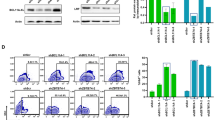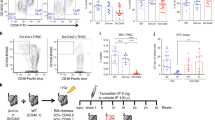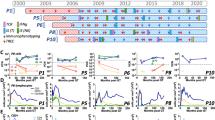Abstract
Hematopoietic stem cells (HSCs) are attractive targets for gene therapy, but current gene transfer methodologies are inadequate for efficient HSC transduction and perpetual transgene expression. To improve gene transfer vectors and transduction protocols, it is vital to establish a system to evaluate transgene expression and the long-term behavior of transduced cells in vivo. For this purpose, we constructed a bicistronic retrovirus encoding the human CD24 (as the first cistron) and the enhanced green fluorescent protein (EGFP; as the second cistron). Murine bone marrow cells were transduced with this vector and the transgene expression was monitored along with hematopoietic reconstitution. Stable expression of CD24 and EGFP was demonstrated in the long-term repopulating cells for at least 6 months, and multi-parameter flow cytometry illustrated expression of both markers in all the lymphohematopoietic lineages examined (B and T lymphoid, erythroid and myeloid). Sustained expression was also shown in the secondary transplants for 6 months, suggesting that self-renewing HSCs were transduced by this vector. Overall, EGFP-tagged bicistronic retroviruses would provide powerful tools for detailed in vivo analysis of transduced hematopoietic cells, such as transgene expression in conjunction with lineage differentiation.
This is a preview of subscription content, access via your institution
Access options
Subscribe to this journal
Receive 12 print issues and online access
$259.00 per year
only $21.58 per issue
Buy this article
- Purchase on Springer Link
- Instant access to full article PDF
Prices may be subject to local taxes which are calculated during checkout




Similar content being viewed by others
References
Karlsson S . Treatment of genetic defects in hematopoietic cell function by gene transfer Blood 1991 78: 2481–2492
Chu P, Lutzko C, Stewart AK, Dubé ID . Retrovirus-mediated gene transfer into human hematopoietic stem cells J Mol Med 1998 76: 184–192
Dunbar CE, Young NS . Gene marking and gene therapy directed at primary hematopoietic cells Curr Opin Hematol 1996 3: 430–437
Miller DG, Adam MA, Miller AD . Gene transfer by retrovirus vectors occurs only in cells that are actively replicating at the time of infection Mol Cell Biol 1990 10: 4239–4242
Orlic D et al. The level of mRNA encoding the amphotropic retrovirus receptor in mouse and human hematopoietic stem cells is low and correlates with the efficiency of retrovirus transduction Proc Natl Acad Sci USA 1996 93: 11097–11102
Kohn DB et al. T lymphocytes with a normal ADA gene accumulate after transplantation of transduced autologous umbilical cord blood CD34+ cells in ADA-deficient SCID neonates Nature Med 1998 4: 775–780
Riddell SR et al. T-cell mediated rejection of gene-modified HIV-specific cytotoxic T lymphocytes in HIV-infected patients Nature Med 1996 2: 216–223
Bonini C et al. HSV-TK gene transfer into donor lymphocytes for control of allogeneic graft-versus-leukemia Science 1997 276: 1719–1724
Kume A et al. Hematopoietic stem cell gene therapy: a current overview Int J Hematol 1999 69: 227–233
Phillips K et al. Cell-surface markers for assessing gene transfer into human hematopoietic cells Nature Med 1996 2: 1154–1156
Dunbar CE et al. Retrovirally marked CD34-enriched peripheral blood and bone marrow cells contribute to long-term engraftment after autologous transplantation Blood 1995 85: 3048–3057
Fields-Berry SC, Halliday AL, Cepko CL . A recombinant retrovirus encoding alkaline phosphatase confirms clonal boundary assignment in lineage analysis of murine retina Proc Natl Acad Sci USA 1992 89: 693–697
Strair RK, Towle M, Smith BR . Retroviral mediated gene transfer into bone marrow progenitor cells: use of beta-galactosidase as a selectable marker Nucleic Acids Res 1990 18: 4759–4762
Pawliuk R, Kay R, Lansdorp P, Humphries RK . Selection of retrovirally transduced hematopoietic cells using CD24 as a marker of gene transfer Blood 1994 84: 2868–2877
Chalfie M et al. Green fluorescent protein as a marker for gene expression Science 1994 263: 802–805
Cubitt AB et al. Understanding, improving and using green fluorescent proteins Trends Biochem Sci 1995 20: 448–455
Cubitt AB, Woollenweber LA, Heim R . Understanding structure–function relationships in the Aequorea victoria green fluorescent protein Meth Cell Biol 1999 58: 19–30
Yang T-T, Cheng L, Kain SR . Optimized codon usage and chromophore mutations provide enhanced sensitivity with the green fluorescent protein Nucleic Acids Res 1996 24: 4592–4593
Persons DA et al. Retroviral-mediated transfer of the green fluorescent protein gene into murine hematopoietic cells facilitates scoring and selection of transduced progenitors in vitro and identification of genetically modified cells in vivo Blood 1997 90: 1777–1786
Bierhuizen MFA et al. Enhanced green fluorescent protein as selectable marker of retroviral-mediated gene transfer in immature hematopoietic bone marrow cells Blood 1997 90: 3304–3315
Bagley J, Aboody-Guterman K, Breakefield X, Iacomini J . Long-term expression of the gene encoding green fluorescent protein in murine hematopoietic cells using retroviral gene transfer Transplantation 1998 65: 1233–1240
Kume A, Hashiyama M, Suda T, Ozawa K . Green fluorescent protein as a selectable marker of retrovirally transduced hematopoietic progenitors Stem Cells 1999 17: 226–232
Hawley RG, Lieu FHL, Fong AZC, Hawley TS . Versatile retroviral vectors for potential use in gene therapy Gene Therapy 1994 1: 136–138
Duke GM, Hoffman MA, Palmenberg AC . Sequence and structural elements that contribute to efficient encephalomyocarditis virus RNA translation J Virol 1992 66: 1602–1609
Urabe M et al. A novel dicistronic AAV vector using a short IRES segment derived from hepatitis C virus genome Gene 1997 200: 157–162
Zitvogel L et al. Construction and characterization of retroviral vectors expressing biologically active human interleukin-12 Hum Gene Ther 1994 5: 1493–1506
Onodera M et al. A simple and reliable method for screening retroviral producer clones without selectable markers Hum Gene Ther 1997 8: 1189–1194
Hanenberg H et al. Colocalization of retrovirus and target cells on specific fibronectin fragments increases genetic transduction of mammalian cells Nature Med 1996 2: 876–882
Ding C et al. High-level reconstitution of respiratory burst activity in a human X-linked chronic granulomatous disease (X-CGD) cell line and correction of murine X-CGD bone marrow cells by retroviral-mediated gene transfer of human gp91phox Blood 1996 88: 1834–1840
Lemischka IR, Raulet DH, Mulligan RC . Developmental potential and dynamic behavior of hematopoietic stem cells Cell 1986 45: 917–927
Quinn ER, Lum LG, Trevor KT . T cell activation modulates retrovirus-mediated gene expression Hum Gene Ther 1998 9: 1457–1467
Allay JA et al. In vivo selection of retrovirally transduced hematopoietic stem cells Nature Med 1998 4: 1136–1143
Donahue RE et al. High levels of lymphoid expression of enhanced green fluorescent protein in nonhuman primates transplanted with cytokine-mobilized peripheral blood CD34+ cells Blood 2000 95: 445–452
Stripecke R et al. Immune response to green fluorescent protein: implications for gene therapy Gene Therapy 1999 6: 1305–1312
Sellers SE et al. No discrepancy between in vivo gene marking efficiency assessed in peripheral blood populations compared with bone marrow progenitors or CD34+ cells Hum Gene Ther 1999 10: 633–640
Correll PH, Colilla S, Karlsson S . Retroviral vector design for long-term expression in murine hematopoietic cells in vivo Blood 1994 84: 1812–1822
Migita M et al. Selection of transduced CD34+ progenitors and enzymatic correction of cells from Gaucher patients, with bicistronic vectors Proc Natl Acad Sci USA 1995 92: 12075–12079
Pear WS, Nolan GP, Scott ML, Baltimore D . Production of high-titer helper-free retroviruses by transient transfection Proc Natl Acad Sci USA 1993 90: 8392–8396
Kitamura T et al. Efficient screening of retroviral cDNA expression libraries Proc Natl Acad Sci USA 1995 92: 9146–9150
Yasueda H et al. High-level direct expression of semi-synthetic human interleukin-6 in Escherichia coli and production of N-terminus Met-free product Biotechnology 1990 8: 1036–1040
Ito K et al. Development of a novel selective amplifier gene for controllable expansion of transduced hematopoietic cells Blood 1997 90: 3884–3892
Matsuda KM et al. Development of a modified selective amplifier gene for hematopoietic stem cell gene therapy Gene Therapy 1999 6: 1038–1044
Xu R et al. A selective amplifier gene for tamoxifen-inducible expansion of hematopoietic cells J Gene Med 1999 1: 236–244
Acknowledgements
We are grateful to Amgen for SCF, Ajinomoto for IL-6, Takara Shuzo for RetroNectin, and Chugai Pharmaceuticals for Epo and G-CSF. This work was supported in part by Grants-in-Aid for Scientific Research from the Ministry of Education, Science, Sports and Culture of Japan, and Grants-in-Aid from the Ministry of Health and Welfare of Japan. AK was a recipient of Jichi Medical School Young Investigator Award.
Author information
Authors and Affiliations
Rights and permissions
About this article
Cite this article
Kume, A., Xu, R., Ueda, Y. et al. Long-term tracking of murine hematopoietic cells transduced with a bicistronic retrovirus containing CD24 and EGFP genes. Gene Ther 7, 1193–1199 (2000). https://doi.org/10.1038/sj.gt.3301225
Received:
Accepted:
Published:
Issue Date:
DOI: https://doi.org/10.1038/sj.gt.3301225



